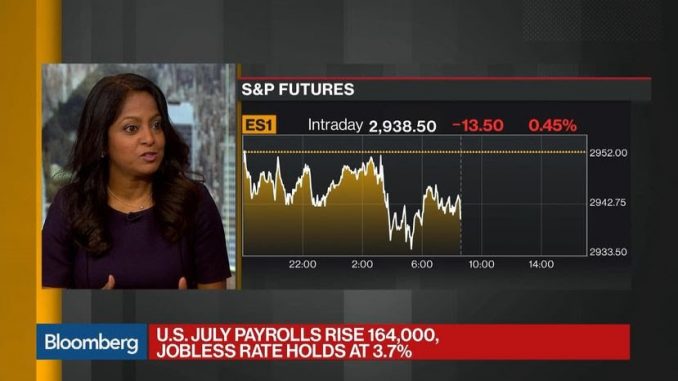
(Bloomberg) — U.S. employers kept adding workers at a healthy pace in July and wage gains picked up, underlining a solid labor market ahead of this week’s Federal Reserve interest-rate cut and President Donald Trump’s threat to ratchet up tariffs on Chinese goods.
Payrolls rose 164,000, almost matching projections, though the two prior months were revised lower, according to a Labor Department report Friday. The jobless rate held at 3.7%, near a half-century low, while average hourly earnings climbed 3.2% from a year earlier, better than forecast.
Despite July’s healthy payrolls figure, the three-month average increase of 140,000 was the slowest in almost two years. That trend is in line with forecasts for a gradual slowing of job gains as the labor market tightens, but it could also be seen as a sign that the economy is losing steam.
Investors boosted bets on additional reductions after Trump’s latest trade salvo on Thursday. The Fed had signaled a day earlier that its quarter-point interest-rate cut would likely start only a short round of monetary easing, though Chairman Jerome Powell indicated that the central bank was watching trade developments closely.
“This is a report that is status quo for the Fed,” Subadra Rajappa, head of U.S. rates strategy at Societe Generale in New York. said on Bloomberg Television. “I think the focus is going to be on all the other events and the rhetoric around tariffs going forward.”
Traders of fed funds futures marginally trimmed the amount of easing they expect from the U.S. central bank this year. The 10-year Treasury yield remained lower on the day at around 1.88%, while the Bloomberg dollar index was up less than 0.1%.
Revisions subtracted 41,000 jobs from the prior two months. The June figure was lowered from 224,000 to a less-eye-popping 193,000.
At the same time, the average workweek got shorter, which also has the effect of boosting average hourly pay. The average for all private employees decreased to 34.3 hours, from 34.4 hours, as manufacturing hours touched their lowest point since November 2011.
What Our Economists Say
“The consensus forecast was off by just 1,000 on July payrolls, but the net takeaway was considerably weaker in light of downward revisions and a pullback in the workweek.”– Carl Riccadonna, Yelena Shulyatyeva and Eliza WingerClick here to read the full note.
The consensus forecast was off by just 1k on July payrolls, but the net takeaway was considerably weaker in light of downward revisions and a pullback in the workweek.
The job gains were led by service providers, particularly in education and health services, as well as professional and business services. Retail payrolls fell for a six month, while manufacturing added the most in six months. Construction gains were relatively weak, at 4,000.
(snip)
The participation rate, or share of working-age people in the labor force, increased to 63% as the count of both employed and unemployed Americans increased in the household survey.
Payroll growth is “still in excess of what we need to see to keep up with population growth,” said Michelle Meyer, head of U.S. economics at Bank of America Corp. “It still suggests that the economy is growing above trend, but there’s been some moderation.”
Other Details
- The U-6, or underemployment rate, fell to 7%, the lowest since 2000, from 7.2%; the gauge includes part-time workers who’d prefer a full-time position and people who want a job but aren’t actively looking.
- Private employment rose by 148,000 after increasing 179,000; government payrolls rose by 16,000.
- There was no indication that hiring of temporary census workers had a significant effect on payrolls.
- Economists surveyed by Bloomberg had projected 165,000 new jobs with unemployment at 3.6% and annual wage gains at 3.1%.
*see full story by Bloomberg